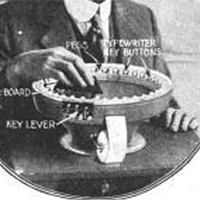Sunker Bisey was a remarkable figure, who rose to fame and fortune as an atomic iodine magnate after iodine treatments saved his life from malaria. In the early 1920s, he set out to create a foolproof alternative to the then popular ouija board. His "Spirit Typewriter" was totally unmarked, and operated with a triangular planchette that depressed typwriter-like keys. As the circular device was given a good spin before using, and the messages typed out-of-sight from the bottom of the device, it was hoped that more honest communications might be received untainted by human influence. Accounts indicate that Bisey only made one copy of his invention, and it was never manufactured on a large scale. But it gained enough attention to be featured in Popular Science, and received a patent in 1922.
Soon after Dr. Bisey's arrival in America, the country became gripped in the post-war Ouija craze of the early 1920s. Dr. Bisey turned his attentions to spirit communications in much the same way as Dr. Robert Hare had 70 years previously. Unpersuaded by talking board communication where users could see the board's letters as their hands supposedly exerted no influence on the direction of the planchette, he set out to invent a foolproof device that users could not manipulate. This device took the form of a circular, hollow-based steel table approximately 12-inches in diameter, around whose perimeter was mounted an arrangement of 36 modified typewriter keys. The keys were blank, though each corresponded to a number or letter. The idea was that the user would sit at the board and allow the planchette to move as normal, after, of course, giving the device a good randomness-assuring spin. As the triangular planchette (apparently the star-shaped design in the patent was abandoned in production) came in contact with the blank typewriter keys, they would trigger their levers and stamp a roll of receipt-like paper hidden in the device's base. After a session, the paper could then be torn off and any messages read. Honesty-though undoubtedly not accuracy-could then be assured.
While the device was patented June 27, 1922, it is highly unlikely more than a prototype was ever produced. Without a user's senses to guide the ideomotor effect, it is most probable that in his attempts to create a device to provide "honest" spirit communications and debunk the ouija-board craze of the period, he also sapped any potential fun out of the proceedings, and the American public, as keen as they were to purchase the latest craze, were simply not going to spend the money on an expensive device that gave only garbled messages of random letters.
Though Dr. Bisey made a fortune on his new iodine enterprise with the aid and promotion of famed psychic Edgar Cayce, his digestible form of iodine worked perhaps too well in an age where many suffered from goitre and other nutritional deficiencies from lack of the element. As his own fortunes rose as one of the few manufacturers of the supplement, so did the establishment's recognition for its need, and the introduction of iodised salt by Morton Salt Company effectively ended Bisey's monopoly on the substance and bankrupted his company. Dr. Bisey died in 1935, and his son eventually sold the family business to Cayce-product promoters The Heritage Store of Virginia Beach, Virginia, which continues to offer original Atomidine to the present day.






